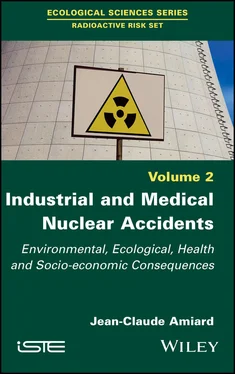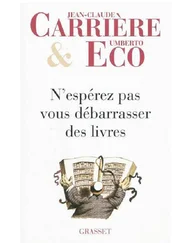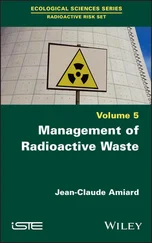The continuous radioactive releases consisted almost entirely of radioactive gases, with very small quantities of radioactive iodine. The highest measured ground dose rate was 1.3.10 2C.kg −1(50 mR.h −1) and the highest concentration of 131I was less than 3.7.10 −6Bq.cm −3[HUL 89].
For example, honey samples were collected in the summer and fall of 1979 from hives within 16 km of the Three Mile Island generating station. None of the seven samples showed overall radioactivity significantly different from that of the control samples collected at a distance of more than 250 km [MOR 80]. These results confirm the findings of previous studies suggesting that only minimal quantities of 137Cs escaped from the damaged Three Mile Island station after the accident.
In contrast, Field [FIE 93] found that the tongues of white-tailed deer ( Odocoileus virgianus ) caught in the 10 counties of Pennsylvania more than 88 km from Three Mile Island had levels 137Cs higher than those of deer tongues tested in the counties surrounding the nuclear power plant. Similarly, in the thyroid glands of meadow voles ( Microtus pennsylvanicus ) trapped near the Three Mile Island nuclear power plant (1.9 km from the reactor) between April 6 and 16, 1979, the amounts of 131I were significantly higher than those in voles captured further away [FIE 81].
Following the failure of the Church Rock uranium mine dike, the total mass of uranium and gross alpha activity released into the Puerco River was estimated at 560.10 6g or 260 Ci. The accidental spill into the water on July 16, 1979 was 1.5.10 6g of uranium and 46 Ci (1,7 TBq) of gross activity [VAN 92].
The fire at the La Hague silo led to air contamination during the fire. All air contamination measurements made during the event revealed only the release of cesium 137 with maximum concentrations of 48.1 GBq.m −3of air. After detailed studies, total cesium 137 releases were estimated to be between 740 and 1,850 GBq. The fire also caused soil contamination with very low contamination areas. This contamination was found inside the site on about one hectare; it affected building 130 overlooking the silo and the surrounding areas. The maximum values recorded were 111.10 3Bq.m −2cesium 137 at the site, and contamination remained low off-site and did not exceed 3.7.10 2Bq.m −2of cesium 137.
Gamma-emitting radionuclides from discharges from the Chalk River Laboratories were only present in the sediments of the Ottawa River in the immediate vicinity of the outfall and were no longer detected 2 km downstream. These detected anthropogenic radionuclides were 60Co, 94Nb, 137Cs, 152Eu, 154Eu, 155Eu and 241Am [ROW 12].
Apparently, no radioactive contamination studies around the Simi Valley site were conducted after the 1959 nuclear accident or at least made public. Some data still appear about the situation 40 years later. Rogers [ROG 12] discussed a 1999 report by Foster Wheeler Environmental Company in Costa Mesa that found that soils contained strontium 90 concentrations 27 times higher than normal.
Health consequences affect two distinct populations: nuclear workers and the general population. Unfortunately, although health data concerning the professional nuclear sector are provided, for some accidents, data are limited.
Historically, people working in uranium mines have suffered very high doses of radiation. The exposure doses of miners are mainly due to radon degradation products (RDPs). These doses are often expressed in unit-alpha-months (UAM) and one UAM is equivalent to 5 mSv, based on an average of 2,000 hours worked per year. As before 1950, workers were exposed to high doses of RDP, and their mortality rate from lung cancer was much higher than that of the rest of the male population.
In Canada, average doses of RDPs have decreased from more than 400 UAM (2000 mSv) in 1940 to less than 2.3 UAM (11.5 mSv) in 1970. Exposure to RDPs was reduced more than four times from 1970 (≤2.3 UAM or 11.5 mSv) to 2000 (≤0.5 UAM or 2.5 mSv). Exposure to the RDPs from 1975 to 2000 for all Saskatchewan mining facilities ranged from 0.2 to 1 UAM. Starting in 1979, the average RDP dose (due to radon alone) was kept below 0.2 UAM (1 mSv) at all times. The average external dose since 1975 has been kept below 2 mSv and has been reduced to less than 1 mSv since 1994 [CCS 14a, CCS 14b].
According to Roscoe et al . [ROS 83], the main reason for the overall increase in mortality in the American white miner cohort was higher rates of lung cancer deaths, accidents and non-malignant respiratory diseases (NMRDs).
Canadian studies have linked lung cancer in uranium miners to exposure to ionizing radiation [CCS 15, HOW 15]. According to the CCSN [CCS 14a], workers at the Port Radium mine in the Northwest Territories have received the highest doses of RDPs, approximately 900 mSv, during their careers. The RDP doses reported for the Port Radium mine in the 1940s were in the order of 450 UAM or 2,250 mSv, while those reported in 2013 for Saskatchewan mines were in the range of 0.05 UAM or 0.25 mSv. These doses are also below the radon threshold recommended by Santé Canada in its guideline for domestic radon, 200 Bq.m −3(i.e. nearly 2 mSv).
Among the 8,487 miners in Saskatchewan from 1948 to 1980, 65 lung cancers were detected, which is significantly higher than testimonies report [HOW 86]. The lung cancer mortality rate in the uranium miners cohort in Ontario was 34% higher than that in the Canadian population (SMR = 1.34, 95% CI 1.27–1.42), as concluded by the OCRC report, and the incidence of lung cancer among uranium miners in Ontario was 30% higher than that in the Canadian population (SIR = 1.30, 95% CI 1.23–1.37) [KUS 93, OCR 15].
In the United States, as early as 1964, Wagener et al . [WAG 64] considered that from the evidence available, the start of the increase in respiratory cancer among American uranium miners necessarily involved radiation from the mining atmosphere. Among the 459 residents who had worked in American underground uranium mines (Uravan, Colorado), a significant increase in lung cancer was found (SMR 2.00; 95% CI 1.39–2.78). This community cohort study revealed a significant excess of lung cancer in men who had been employed as underground miners. Similarly, increased mortality was observed among the 1,735 underground uranium miners in Grants, New Mexico, from 1955 to 1990. This was a result of respiratory diseases, either malignant (SMR 2.17; 95% CI 1.75–2.65; n = 95) or non-malignant (SMR 1.64; 95% CI 1.23–2.13; n = 55), cirrhosis of the liver (SMR 1.79; n = 18) and external causes (SMR 1.65; n = 58). The likely excess lung cancer level was down to historically high levels of radon in uranium mines on the Colorado Plateau combined with intensive use of tobacco products [BOI 07, BOI 08].
In France, the miners cohort has a statistically significant excess mortality rate for liver cancers (SMR = 1.75; 95% CI 1.01–2.80) [BOV 16]. As Tomasek et al . [TOM 08] in a study of Czech and French uranium miners concluded: “There have been excessive reports of lung cancer, reduced lung function and emphysema. This excess has mainly been attributed to the irradiation of the tracheobronchial epithelium by particles emitted during the radioactive decay of radon and its derivatives”. An epidemiological study [AMA 09] among French miners reveals a significant association between the relative risk of lung cancer and silicosis (OR silicosis = 3.6; 95% CI 1.4–8.9), and the relationship between radon and lung cancer persists after adjustment for smokers and silicotic status (ERR radon per working month = 1.0%; 95% CI 0.1–3.5%). Radon, smoking and silicotic status appear to be three factors that each have a specific effect on lung cancer risk.
Читать дальше












